Korean cuisine is largely based upon rice, vegetables, and meats. Traditional Korean meals are noted for the number of side dishes (banchan) that accompany steam-cooked short-grain rice. Kimchi is served often, sometimes at every meal. Commonly used ingredients include sesame oil, doenjang (fermented bean paste), soy sauce, salt, garlic, ginger, pepper flakes and gochujang (fermented red chili paste).
Ingredients and dishes vary by province. Many regional dishes have become national, and dishes that were once regional have proliferated in different variations across the country. The Korean royal court cuisine once brought all of the unique regional specialties together for the royal family. Meals are regulated by Korean cultural etiquette.
Grains
 Grains have been one of the most important staples to the Korean diet. Early myths of the foundations of various kingdoms in Korea center on grains. One foundation myth relates to Jumong, who received barley seeds from two doves sent by his mother after establishing the kingdom of Goguryeo. Yet another myth speaks of the three founding deities of Jeju Island, who were to be wed to the three princesses of Tamna; the deities brought seeds of five grains which were the first seeds planted, which in turn became the first instance of farming.
Grains have been one of the most important staples to the Korean diet. Early myths of the foundations of various kingdoms in Korea center on grains. One foundation myth relates to Jumong, who received barley seeds from two doves sent by his mother after establishing the kingdom of Goguryeo. Yet another myth speaks of the three founding deities of Jeju Island, who were to be wed to the three princesses of Tamna; the deities brought seeds of five grains which were the first seeds planted, which in turn became the first instance of farming.During the pre-modern era, grains such as barley and millet were the main staples and were supplemented by wheat, sorghum, and buckwheat. Rice is not an indigenous crop to Korea, and millet was likely the preferred grain before rice was cultivated. Rice became the grain of choice during the Three Kingdoms period, particularly in the kingdoms of Silla and Baekje in the southern regions of the peninsula. Rice was such an important commodity in Silla that it was used to pay taxes. The Sino-Korean word for "tax" is a compound character that uses the character for the rice plant. The preference for rice escalated into the Joseon period, when new methods of cultivation and new varieties emerged that would help increase production.
As rice was prohibitively expensive when it first came to Korea, the grain likely was mixed with other grains to "stretch" the rice; this is still done in dishes such as boribap (rice with barley) and kongbap (rice with beans). White rice, which is rice with the bran removed, has been the preferred form of rice since its introduction into the cuisine. The most traditional method of cooking the rice has been to cook it in an iron pot called a sot (솥) or musoe sot (무쇠솥). This method of rice cookery dates back at least to the Goryeo period, and these pots have even been found in tombs from the Silla period. The sot is still used today, much in the same manner as it was in the past centuries.
Rice is used to make a number of items, outside of the traditional bowl of plain white rice. It is commonly ground into a flour and used to make rice cakes called tteok in over two hundred varieties. It is also cooked down into a congee (juk), or gruel (mieum) and mixed with other grains, meat, or seafood. Koreans also produce a number of rice wines, both in filtered and unfiltered versions.
Legumes
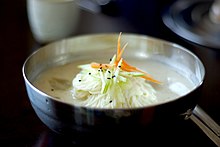 Legumes have been significant crops in Korean history and cuisine according to earliest preserved legumes found in archaeological sites in Korea. The excavation at Okbang site, Jinju, South Gyeongsang province indicates soybeans were cultivated as a food crop circa 1000–900 BCE. They are made into tofu (dubu), while soybean sprouts are sauteed as a vegetable (kongnamul) and whole soybeans are seasoned and served as a side dish. They are also made into soy milk, which is used as the base for the noodle dish called kongguksu. A byproduct of soy milk production is okara (kongbiji), which is used to thicken stews and porridges. Soybeans may also be one of the beans in kongbap, which boil together with several types of beans and other grains, and they are also the primary ingredient in the production of fermented condiments collectively referred to as jang, such as soybean pastes, doenjang and cheonggukjang, a soy sauce called ganjang, chili pepper paste or gochujang and others.
Legumes have been significant crops in Korean history and cuisine according to earliest preserved legumes found in archaeological sites in Korea. The excavation at Okbang site, Jinju, South Gyeongsang province indicates soybeans were cultivated as a food crop circa 1000–900 BCE. They are made into tofu (dubu), while soybean sprouts are sauteed as a vegetable (kongnamul) and whole soybeans are seasoned and served as a side dish. They are also made into soy milk, which is used as the base for the noodle dish called kongguksu. A byproduct of soy milk production is okara (kongbiji), which is used to thicken stews and porridges. Soybeans may also be one of the beans in kongbap, which boil together with several types of beans and other grains, and they are also the primary ingredient in the production of fermented condiments collectively referred to as jang, such as soybean pastes, doenjang and cheonggukjang, a soy sauce called ganjang, chili pepper paste or gochujang and others.Mung beans are commonly used in Korean cuisine, where they are called nokdu (绿豆, literally "green bean"). Mung bean sprouts, called sukju namul, are often served as a side dish, blanched and sautéed with sesame oil, garlic, and salt. Ground mung beans are used to make a porridge called nokdujuk, which is eaten as a nutritional supplement and digestive aid, especially for ill patients. A popular snack, bindaetteok (mung bean pancake) is made with ground mung beans and fresh mung bean sprouts. Starch extracted from ground mung beans is used to make transparent cellophane noodles (dangmyeon). The noodles are the main ingredients for japchae (a salad-like dish), and sundae (a blood sausage) or a subsidiary ingredient for soups and stews. The starch can be also used to make jelly-like foods, such as nokdumuk and hwangpomuk. The muk have a bland flavor, so are served seasoned with soy sauce, sesame oil and crumbled seaweeds or other seasonings such as tangpyeongchae.
Cultivation of azuki beans dates back to ancient times according to an excavation from Odong-ri, Hoeryong, North Hamgyong Province, which is assumed to be that of Mumun period (approximately 1500-300 BCE). Azuki beans are generally eaten as patbap, which is a bowl of rice mixed with the beans, or as a filling and covering for tteok (rice cake) and breads. A porridge made with azuki beans, called patjuk, is commonly eaten during the winter season. On Dongjinal, a Korean traditional holiday which falls on December 22, Korean people eat donji patjuk, which contains saealsim (새알심), a ball made from glutinous rice flour. In old Korean tradition, patjuk is believed to have the power to drive evil spirits away.
Condiments and seasoning
Condiments are divided into fermented and nonfermented variants. Fermented condiments include ganjang, doenjang, gochujang and vinegars. Nonfermented condiments or spices include red pepper, black pepper, Chinese pepper, cordifolia, mustard, chinensis, garlic, onion, ginger, leek, and scallion (spring onion).Meat
In antiquity, most meat in Korea was likely obtained through hunting and fishing. Ancient records indicate rearing of livestock began on a small scale during the Three Kingdoms period. Meat was consumed roasted or in soups or stews during this period. Those who lived closer to the oceans were able to complement their diet with more fish, while those who lived in the interior had a diet containing more meat.- Beef
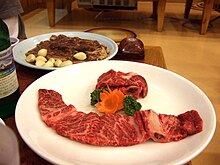 Beef is the most prized of all meats, with the cattle holding an important cultural role in the Korean home. The cattle were valuable draught animals and were regarded more as servants than for consumption. They were also seen as equal to human servants, or in some cases, members of family. Cattle were also given their own holiday during the first 'cow' day of the lunar New Year. The importance of cattle does not suggest Koreans ate an abundance of beef, however, as the cattle were valued as beasts of burden and slaughtering one would create dire issues in farming the land. Pork and seafood were more likely consumed on a more regular basis, due to this issue. The Buddhist ruling class of the Goryeo period forbade the consumption of beef. The Mongols dispensed with the ban of beef during the 13th century, and they promoted the production of beef cattle. This increased production continued into the Joseon period, when the government encouraged both increased quantities and quality of beef.
Beef is the most prized of all meats, with the cattle holding an important cultural role in the Korean home. The cattle were valuable draught animals and were regarded more as servants than for consumption. They were also seen as equal to human servants, or in some cases, members of family. Cattle were also given their own holiday during the first 'cow' day of the lunar New Year. The importance of cattle does not suggest Koreans ate an abundance of beef, however, as the cattle were valued as beasts of burden and slaughtering one would create dire issues in farming the land. Pork and seafood were more likely consumed on a more regular basis, due to this issue. The Buddhist ruling class of the Goryeo period forbade the consumption of beef. The Mongols dispensed with the ban of beef during the 13th century, and they promoted the production of beef cattle. This increased production continued into the Joseon period, when the government encouraged both increased quantities and quality of beef.Only in the latter part of the 20th century has beef become regular table fare. Beef is prepared in numerous ways today, including roasting, grilling (gui) or boiling in soups. Beef can also be dried into jerky, as with seafood, called respectively yukpo and eopo.
- Chicken
- Pork
Fish and seafood
Fish and shellfish have been a major part of Korean cuisine because of the oceans bordering the peninsula. Evidence from the 12th century illustrates commoners consumed a diet mostly of fish and shellfish, such as shrimp, clams, oysters, abalone, and loach, while sheep and hogs were reserved for the upper class.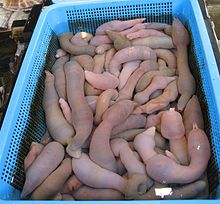 Both fresh and saltwater fish are popular, and are served raw, grilled, broiled, dried or served in soups and stews. Common grilled fish include mackerel, hairtail, croaker and Pacific herring. Smaller fish, shrimp, squid, mollusks and countless other seafood can be salted and fermented as jeotgal. Fish can also be grilled either whole or in fillets as banchan. Fish is often dried naturally to prolong storing periods and enable shipping over long distances. Fish commonly dried include yellow corvina, anchovies (myeolchi) and croaker. Dried anchovies, along with kelp, form the basis of common soup stocks.
Both fresh and saltwater fish are popular, and are served raw, grilled, broiled, dried or served in soups and stews. Common grilled fish include mackerel, hairtail, croaker and Pacific herring. Smaller fish, shrimp, squid, mollusks and countless other seafood can be salted and fermented as jeotgal. Fish can also be grilled either whole or in fillets as banchan. Fish is often dried naturally to prolong storing periods and enable shipping over long distances. Fish commonly dried include yellow corvina, anchovies (myeolchi) and croaker. Dried anchovies, along with kelp, form the basis of common soup stocks.Shellfish is widely eaten in all different types of preparation. They can be used to prepare broth, eaten raw with chogochujang, which is a mixture of gochujang and vinegar, or used as a popular ingredient in countless dishes. Raw oysters and other seafood can be used in making kimchi to improve and vary the flavor. Salted baby shrimp are used as a seasoning agent, known as saeujeot, for the preparation of some types of kimchi. Large shrimp are often grilled as daeha gui (대하구이) or dried, mixed with vegetables and served with rice. Mollusks eaten in Korean cuisine include octopus, cuttlefish, and squid.
Vegetables
Korean cuisine uses a wide variety of vegetables, which are often served uncooked, either in salads or pickles, as well as cooked in various stews, stir-fried dishes, and other hot dishes. Commonly used vegetables include Korean radish, Napa cabbage, cucumber, potato, sweet potato, spinach, bean sprouts, scallions, garlic, chili peppers, seaweed, zucchini, mushrooms and lotus root. Several types of wild greens, known collectively as chwinamul (such as Aster scaber), are a popular dish, and other wild vegetables such as bracken fern shoots (gosari) or Korean bellflower root (doraji) are also harvested and eaten in season. Medicinal herbs, such as ginseng, reishi, wolfberry, Codonopsis pilosula, and Angelica sinensis, are often used as ingredients in cooking, as in samgyetang.Medicinal foods
Medicinal food (boyangsik) is a wide variety of specialty foods prepared and eaten for medicinal purposes, especially during the hottest 30-day period in the lunar calendar, called sambok. Hot foods consumed are believed to restore ki, as well as sexual and physical stamina lost in the summer heat Commonly eaten boyangshik include: ginseng, chicken, dog, abalone, eel, carp, bone marrow, pig kidneys and black goat. These foods are popularly consumed by groups of men as a macho, backslapping activity.Dog Meat
The consumption of dog meat in what is now Korea dates back to antiquity. Today, the primary dog breed raised for meat, the nureongi (누렁이), differs from those breeds raised for pets, which Koreans may keep in their homes. Dog meat is usually eaten during the summer months, in either roasted form or prepared in soups. The most popular of these soups is gaejang-guk (also called bosintang), a spicy stew which is believed by consumers to balance the body's heat during the summer months; followers of the custom claim this is done to ensure good health by balancing one's gi, or vital energy of the body. A 19th century version of gaejang-guk explains the dish is prepared by boiling dog meat with scallions and chili powder. Variations of the dish contain chicken and bamboo shoots. While the dishes are still popular in Korea with a segment of the population, dog is nowhere near as widely consumed as beef, chicken, and pork.
Regional and variant cuisines
Korean regional cuisines (Korean: hyangto eumsik, literally "native local foods") are characterized by local specialties and distinctive styles within Korean cuisine. The divisions reflected historical boundaries of the provinces where these food and culinary traditions were preserved until modern times.Although Korea has been divided into two nation-states since 1948 (North Korea and South Korea), it was once divided into eight provinces (paldo) according to the administrative districts of the Joseon Dynasty. The northern region consisted of Hamgyeong Province, Pyeongan Province and Hwanghae Province. The central region comprised Gyeonggi Province, Chungcheong Province, and Gangwon Province. Gyeongsang Province and Jeolla Province made up the southern region.
Until the late 19th century, transportation networks were not well developed, and each provincial region preserved its own characteristic tastes and cooking methods. Geographic differences are also reflected by the local specialty foodstuffs depending on the climate and types of agriculture, as well as the natural foods available. With the modern development of transportation and the introduction of foreign foods, Korean regional cuisines have tended to overlap and integrate. However, many unique traditional dishes in Korean regional cuisine have been handed down through the generations.
Buddhist cuisine
Further information: Korean temple cuisine and Buddhist cuisine
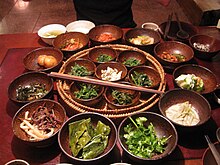 Korean temple cuisine originated in Buddhist temples of Korea. Since Buddhism was introduced into Korea, Buddhist traditions have strongly influenced Korean cuisine, as well. During the Silla period (57 BC – 935 AD), chalbap (찰밥, a bowl of cooked glutinous rice) yakgwa (a fried dessert) and yumilgwa (a fried and puffed rice snack) were served for Buddhist altars and have been developed into types of hangwa, Korean traditional confectionery. During the Goryeo Dynasty, sangchu ssam (wraps made with lettuce), yaksik, and yakgwa
were developed, and since spread to China and other countries. Since
the Joseon Dynasty, Buddhist cuisine has been established in Korea
according to regions and temples.
Korean temple cuisine originated in Buddhist temples of Korea. Since Buddhism was introduced into Korea, Buddhist traditions have strongly influenced Korean cuisine, as well. During the Silla period (57 BC – 935 AD), chalbap (찰밥, a bowl of cooked glutinous rice) yakgwa (a fried dessert) and yumilgwa (a fried and puffed rice snack) were served for Buddhist altars and have been developed into types of hangwa, Korean traditional confectionery. During the Goryeo Dynasty, sangchu ssam (wraps made with lettuce), yaksik, and yakgwa
were developed, and since spread to China and other countries. Since
the Joseon Dynasty, Buddhist cuisine has been established in Korea
according to regions and temples.On the other hand, royal court cuisine is closely related to Korean temple cuisine. In the past, when the royal court maids, sanggung, who were assigned to Suragan (hangul: 수라간; hanja: 水剌間; the name of the royal kitchen), where they prepared the king's meals, became old, they had to leave the royal palace. Therefore, many of them entered Buddhist temples to become nuns. As the result, culinary techniques and recipes of the royal cuisine were integrated into Buddhist cuisine.
Vegetarian cuisine
 Vegetarian cookery in Korea may be linked to the Buddhist traditions that influenced Korean culture from the Goryeo
dynasty onwards. There are hundreds of vegetarian restaurants in Korea,
although historically they have been local restaurants that are unknown
to tourists. Most have buffets, with cold food, and vegetarian kimchi and tofu being the main features. Bibimbap is a common vegan dish. Menus change with seasons. Wine with the alcohol removed and fine teas are also served. The Korean tea ceremony
is suitable for all vegetarians and vegans, and began with Buddhist
influences. All food is eaten with a combination of rather slippery
stainless steel oval chopsticks and a long-handled shallow spoon called together sujeo.
Vegetarian cookery in Korea may be linked to the Buddhist traditions that influenced Korean culture from the Goryeo
dynasty onwards. There are hundreds of vegetarian restaurants in Korea,
although historically they have been local restaurants that are unknown
to tourists. Most have buffets, with cold food, and vegetarian kimchi and tofu being the main features. Bibimbap is a common vegan dish. Menus change with seasons. Wine with the alcohol removed and fine teas are also served. The Korean tea ceremony
is suitable for all vegetarians and vegans, and began with Buddhist
influences. All food is eaten with a combination of rather slippery
stainless steel oval chopsticks and a long-handled shallow spoon called together sujeo.Ceremonial food
Food is an important part of traditions of Korean family ceremonies, which are mainly based on the Confucian culture. Gwan Hon Sang Je (관혼상제; 冠婚喪祭), the four family ceremonies (coming-of-age ceremony, wedding, funeral, and ancestral rite) have been considered especially important and elaborately developed, continuting to influence Korean life to these days. Ceremonial food in Korea has developed with variation across different regions and cultures.For example, Rituals are mainly performed on the anniversary of deceased ancestors, called jesa. Ritual food include rice, liquor, soup, vinegar and soy sauce (1st row); noodles, skewered meat, vegetable and fish dishes, and rice cake (2nd row); three types of hot soup, meat and vegetable dishes (3rd row); dried snacks, kimchi, and sweet rice drink (4th row); and variety of fruit (5th row).
Street food
In South Korea, inexpensive food may be purchased from Pojangmacha, street carts during the day, where customers may eat standing beside the cart or have their food wrapped up to take home. At night, they becomes small tents that sell foods, drinks, and alcoholic beverages. Seasonal foods include hotteok, and bungeoppang, which are enjoyed in autumn and winter. Gimbap and tteokbokki are also very popular street food.Etiquette
Dining
Dining etiquette in Korea can be traced back to the Confucian philosophies of the Joseon period. Guidebooks, such as Sasojeol (士小節, Elementary Etiquette for Scholar Families), written in 1775 by Yi Deokmu (이덕무; 李德懋), comment on the dining etiquette for the period. Suggestions include items such as "when you see a fat cow, goat, pig, or chicken, do not immediately speak of slaughtering, cooking or eating it", "when you are having a meal with others, do not speak of smelly or dirty things, such as boils or diarrhea,"."when eating a meal, neither eat so slowly as to appear to be eating against your will nor so fast as if to be taking someone else's food. Do not throw chopsticks on the table. Spoons should not touch plates, making a clashing sound", amongst many other recommendations which emphasized proper table etiquette.The eldest male at the table was always served first, commonly served to them in the men's quarters by the women of the house. Women usually dined in a separate portion of the house after the men were served. The eldest men or women always ate before the younger family members. The meal was usually quiet, as conversation was discouraged during meals. In modern times, these rules have become lax, as families usually dine together now and use the time to converse. Of the remaining elements of this decorum, one is that the younger members of the table should not pick up their chopsticks or start eating before the elders of the table or guests and should not finish eating before the elders or guests finish eating.
In Korea, unlike in China and Japan, the rice or soup bowl is not lifted from the table when eating from it. This is due to the fact that each diner is given a metal spoon along with the chopsticks known collectively as sujeo. The use of the spoon for eating rice and soups is expected. There are rules which reflect the decorum of sharing communal side dishes; rules include not picking through the dishes for certain items while leaving others, and the spoon used should be clean, because usually diners put their spoons in the same serving bowl on the table. Diners should also cover their mouths when using a toothpick after the meal.
The table setup is important as well, and individual place settings, moving from the diner's left should be as follows: rice bowl, spoon, then chopsticks. Hot foods are set to the right side of the table, with the cold foods to the left. Soup must remain on the right side of the diner along with stews. Vegetables remain on the left along with the rice, and kimchi is set to the back while sauces remain in the front.

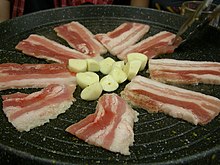


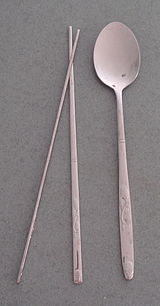
No comments:
Post a Comment